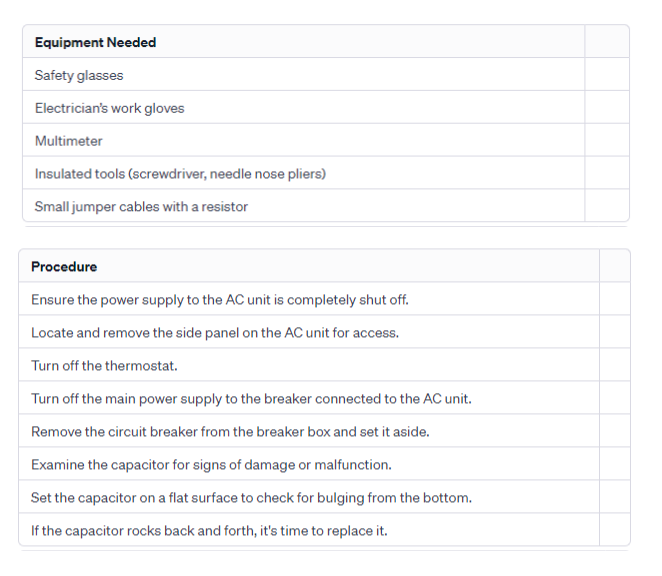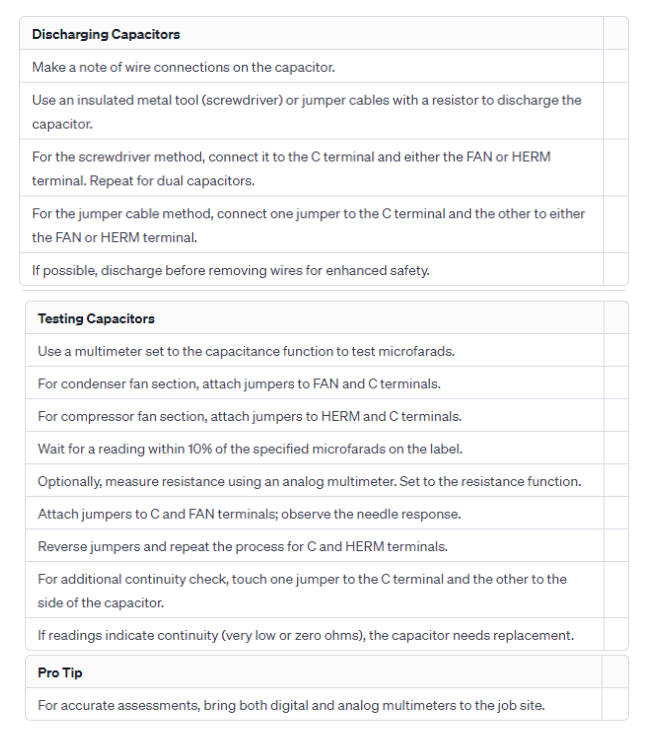janvier 10, 2024
685
Replacing an AC capacitor is a critical aspect of maintaining optimal performance in your air conditioning unit. The capacitor serves as a key component in the system, facilitating the smooth functioning of the motor and ensuring efficient cooling. Over time, wear and tear may compromise its effectiveness, necessitating a replacement. In this guide, we will delve into the step-by-step process of replacing an AC capacitor, emphasizing safety measures, equipment requirements, and crucial testing procedures. Whether you're a DIY enthusiast or seeking insights for professional assistance, understanding the intricacies of AC capacitor replacement is essential for ensuring the longevity and reliability of your cooling system.


To ensure a seamless and secure replacement of your AC capacitor, adhere to these comprehensive steps:
Safety is paramount. Before swapping out the AC capacitor, prioritize safety by discharging the old capacitor to ensure proper disposal. This not only safeguards your well-being but also aligns with environmental responsibility.
Kickstart the replacement process by disconnecting the wires from the aging capacitor. This pivotal step readies the unit for the installation of a new capacitor.
Employ a multimeter for capacitance testing on each terminal. Connect one prong to the C terminal and the other to either the FAN or HERM terminal. A broken capacitor exhibits notably low capacitance compared to the specified value on its label. In instances of dual capacitors, it's imperative to replace them, even if just one terminal displays improper capacitance.
Unscrew the metal strap securing the old capacitor and delicately remove it from the AC unit, ensuring a meticulous and safe removal process.
Extract the new capacitor from its packaging and secure the metal strap around it, ensuring a robust attachment to the AC unit. This step primes the new capacitor for installation.
Affix each wire to the new capacitor, mirroring the configuration of the old one. This guarantees a seamless integration of the new component into the AC unit.
Reinstall the breaker into the breaker box, power up the main supply, and activate the thermostat. These actions reinstate power to the AC unit, commencing the testing phase.
Ascertain that the AC unit is functioning optimally. If you've replaced the capacitor correctly and the unit still faces issues like sluggish performance or inadequate cooling, there might be an underlying problem that warrants further investigation.
Should the metal strap from the old capacitor not fit the new one, contemplate cutting some pipe hanger strap to the necessary length. Fasten it securely by screwing it into the same hole where the original strap was connected. This pro tip ensures adaptability in the face of size variations.
By meticulously adhering to these steps, you not only execute an efficient AC capacitor replacement but also contribute significantly to the overall effectiveness and durability of your AC unit. Regular maintenance and timely replacement of faulty components are pivotal in ensuring optimal performance and prolonged cooling capabilities.
The typical price for an air conditioner capacitor is approximately $180. Keep in mind that actual costs may vary depending on factors such as the capacitor's specifications, brand, and where it is purchased. Additionally, service fees for professional installation, if required, could contribute to the overall expense.
The cost to replace an AC capacitor typically falls within the range of $80 to $400, inclusive of labor. However, the average expense for most homeowners is around $190. Several factors contribute to the variation in costs. For example, the region in which you live can play a significant role. In areas with high temperatures and increased demand for AC technicians, labor costs may be higher compared to cooler regions.
In general, AC capacitors typically have a lifespan of around 20 years. Given this relatively long duration, many heating and AC repair companies often inspect the capacitor as one of the last components during routine maintenance or troubleshooting. However, it's important to note that the lifespan of a capacitor can be influenced by various factors, including usage patterns, environmental conditions, and the overall quality of the capacitor. Regular maintenance and periodic inspections by HVAC professionals can help identify signs of wear and potential issues, allowing for timely replacement before a failure occurs. If you notice any performance issues with your AC unit, it's advisable to have the capacitor checked, even if it has not reached the 20-year mark.
In conclusion, replacing an AC capacitor is a fundamental task that contributes significantly to the overall functionality of your air conditioning unit. By following the outlined steps and safety precautions, you not only enhance the efficiency of your system but also ensure the safety of both yourself and the environment. Regular maintenance and timely capacitor replacements can extend the lifespan of your AC unit, preventing potential breakdowns and reducing the need for extensive repairs. As you embark on this journey of maintaining your cooling system, remember that a well-maintained capacitor is key to enjoying consistent and reliable comfort in your living or working space.
Read More:
Capacitor Symbol in Circuit: A Roadmap for Electronics Enthusiasts